
The jacketed glass reactor is a container to control the temperature of the contents. They can be used to achieve both the heating and the cooling effect around the reactor you want to use. For some glass reactors, they have jackets, and for this reason, people call them jacketed glass reactors. Having a jacket may bring a lot of advantages, for example, they have the ability to make for uniform heat transfer or exchange. And usually, heats are exchanged by the reactants or fluids that are combined in the walls of that vessel.
There are various kinds of glass reactors in the market today, and all of them aim to serve the same purpose. And now, the most popular jacketed glass reactors are plate coils, dimple jackets as well as half pipe coil jackets and the conventional glass jackets, and so on. They are designed for specific purposes.
So, they all have unique features that set them apart from each other. This means that when you are making your choice, you must consider the features of each of them, which will assist you in the final decision you make.
The jacketed glass reactor can serve as a chemical reactor, industrial reactor, pharma reactor, laboratory reactor, and a few other kinds of reactors. Whichever purpose it is used for, the function of it is to facilitate heat exchange.
Although there are different kinds of such jackets in the market, the modern ones have great benefits over others. One reason is that they are designed with the finest glass materials, and because of that, they will not be broken easily. And another one is that they have good airtightness, so they will not leak, causing unexpectable results.
Jacketed Glass Reactor Design
In this part, we will introduce the design of the jacketed glass reactor.
The jacketed glass reactor is circulated through the cold or hot liquid that is filled in the jacket reactor. And under negative or normal pressure, the substances will be stirred in the glass jacketed reactor with good air proof to allow the reaction to take place.
And also, we can observe the reaction process clearly through the transparent reaction flask, completing the total control of your reactions. Therefore, the jacket glass reactor is a wonderful laboratory equipment used for experimentations or in medium production plants in modern pharmacy and biology and the chemical industry for synthesizing materials.
Features of a Jacketed Glass Reactor
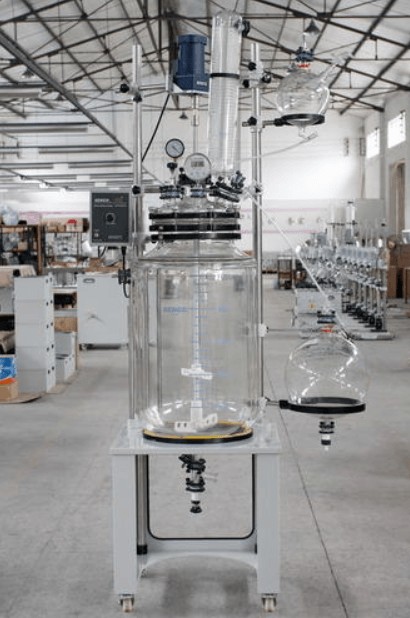
- It has an integrated jacket flask where reactions take place and are a big caliber which is transparent with seal and of high strength
- It has a PTFE cover of high quality that supports high, stirring speed in the vacuum.
- It has three standard mouths that can be used for multipurpose to meet the user’s needs. It has a funnel that provides constant pressure, has the thermometer, feeding cork and a reflux condenser.
- It is designed to contain volumes from 20 liters and more, safe and easy to operate.
The jacketed glass reactor is commonly used for synthesizing chemicals, development process, filtration, workup, purification, stirring, evaporation, mixing, dissolving and extraction of operations in the scientific fields.
Moreover, the jacketed glass reactor also features the ease of use and has an excellent performance when using it. The main component of glass materials is borosilicate of high quality as it cannot react with the solutions in it and are heat resistant.
Besides, the open-frame design of the jacketed glass reactor gives the maximum user accessibility. The frames components are coated with aluminum bases, cross supports, and so on, together with steel to provide optimum strength and durability.
Furthermore, the volumes of the jacketed glass reactor range from 20L up to 200 liters. Although, they have various designs, the main purpose of them is to meet the customer’s needs.
The Specifications of Jacketed Glass Reactor
| Model | S212-05 | S212-10 | S212-20 | S212-50 | S212-100 | S212-200 |
| Reaction Volume(L) | 5L | 10L | 20L | 50L | 100L | 200L |
| Jacket Volume(L) | 2L | 5L | 8L | 12L | 18L | 25L |
| Reactor Material | High quality borosilicate 3.3 glass | High quality borosilicate 3.4 glass | High quality borosilicate 3.5 glass | High quality borosilicate 3.6 glass | High quality borosilicate 3.7 glass | High quality borosilicate 3.8 glass |
| Support Frame Material | Stainless steel 304 and coated aluminum | Stainless steel 304 and coated aluminum | Stainless steel 304 and coated aluminum | Stainless steel 304 and coated aluminum | Stainless steel 304 and coated aluminum | Stainless steel 304 and coated aluminum |
| Neck No. On Lid | 5 | 6 | 6 | 6 | 6 | 6 |
| Rated. torque(N.cm) | 140 | 177 | 177 | 177 | 285 | 550 |
| Motor power(W) | 90 | 120 | 120 | 120 | 200 | 370 |
| Rotating speed(rpm) | 0 ~ 600 (customizable) | 0 ~ 600 (customizable) | 0 ~ 600 (customizable) | 0 ~ 600 (customizable) | 0 ~ 600 (customizable) | 0 ~ 600 (customizable) |
| Power supply | 220V or 110V / 50-60HZ | 220V or 110V / 50-60HZ | 220V or 110V / 50-60HZ | 220V or 110V / 50-60HZ | 220V or 110V / 50-60HZ | 220V or 110V / 50-60HZ |
| Discharge | PTFE (Teflon) bottom discharge valve with no deadspace | PTFE (Teflon) bottom discharge valve with no deadspace | PTFE (Teflon) bottom discharge valve with no deadspace | PTFE (Teflon) bottom discharge valve with no deadspace | PTFE (Teflon) bottom discharge valve with no deadspace | PTFE (Teflon) bottom discharge valve with no deadspace |
| Pressure Range | Full vacuum to atmosphere | Full vacuum to atmosphere | Full vacuum to atmosphere | Full vacuum to atmosphere | Full vacuum to atmosphere | Full vacuum to atmosphere |
| Max jacket pressure | 0.5 bar | 0.5 bar | 0.5 bar | 0.5 bar | 0.5 bar | 0.5 bar |
The Types of Jacketed Glass Reactor

Glass jacketed reactors serve a multitude of uses within the pharmaceutical and chemical processing industries. Often, these glass reactors are encircled by a hollow covering that can be filled with chilled or hot liquid to reduce or improve temperatures inside the vessel. It is an essential solution for managing internal temperatures and, in some cases, decreasing the viscosity of thick, glutinous compounds.
Before buying a jacketed glass reactor, ensure you understand the types of jacketed glass reactors available to you. There are three types: conventional jackets, half-pipe jackets, and dimple jackets. Depending on the intensity of the distillation process and the compounds used, it may be necessary for you to use a double or even triple jacketed reactor.
Let’s take a closer look at the most common jacketed reactors and their applications:
1. Jacketed Agitated Glass Reactor
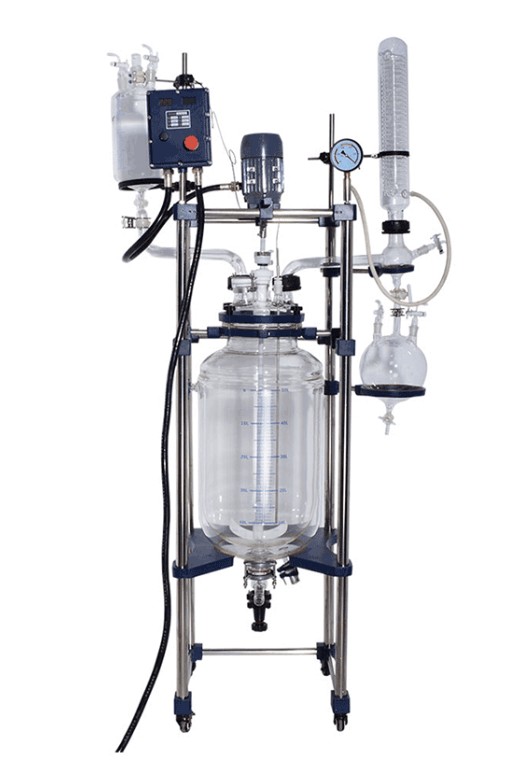
If you’re looking to invest in a premium jacketed agitated reactor, a glass jacketed agitated reactor will be a good choice for you. They are encircled by a glass covering or ‘jacket’, so they can cool or heat their contents with the use of external liquids.
Agitated reactors include a variable speed stirrer and accompanying baffle components designed to maintain movement of the vessel’s contents. The use of a modifiable overflow is another handy feature as it allows the vessel’s internal volume to change increase and decrease as required.
Jacketed agitated reactors can be controlled batch-wise either by filling them right up to the overflow point or constantly dispensing chilled water to their base section. The addition of quick release hot and cold liquid connections is required for optimally efficient reactions between the jacket and internal heating coil.
Thermocouples are found at the (1) cold fluid inlet to vessel, (2) the hot fluid inlet to the coil, (3) the hot fluid inlet to jacket, (4) the hot fluid outlet to the coil and (5) the hot fluid outlet from the jacket.
2. Single Jacketed Glass Reactor

Single jacketed glass reactors are the most basic type of jacket batch vessel. They are used within pharmaceutical and chemical processing industries to manage temperatures inside distillation vats. These specially designed jackets allow for the uniform interchange of heat or cold between the liquids inside its own hollow casing and the compounds inside the reactor.
Single jacketed glass reactors include a reaction lid with multifunctional docks or ‘ports’ that enable operators to carry out various processes. For instance, they can use these docks to add additional compounds to the reactor without affecting its programmed agitation speed or temperature. They can also monitor internal temperatures, add powders to the reactor and retrieve fully distilled materials.
The highest quality single-layer jacket reactors feature solvent resistant PTFE on all sealing components to guarantee the longevity of their parts even under extreme conditions. They also come with a centrally positioned downward drain port that is tilted to ensure maximum efficiency when in operation. If you’re willing to spend more, you can get a glass reactor with integrated digital speed and temperature displays on its outside.
3. Double Jacketed Glass Reactor

Double jacketed glass reactors are commonly used to contain and control reactions that involve extreme temperatures. They come with both an inner jacket for controlled cooling or heating and an external jacket for greater vacuum insulation. This outer jacket also prevents excess moisture from accumulating. It’s an important piece of equipment for operators who need a high degree of visibility into the glass reactor.
This type of glass reactor is able to manage synthetic reactions between a wide variety of different compounds. The important thing is it achieves this without disrupting the vessel’s programmed temperatures or vacuum conditions.
To operate a jacketed glass reactor correctly and at optimum efficiency, you first need a chemical protected vacuum pump, a cold trap, and a chiller. Your chosen chiller component must have the capacity to reduce the reactor’s internal temperature almost instantly. The cold trap is necessary for containing vapors that escape through the condenser unit.
4. Three-Layer Jacketed Glass Reactor

The innovative design of the three-layer jacketed glass reactor makes it perfect for efficient, error-free molecular distillation and other similar chemical processes. The most practical versions come with an ‘easy use’ reactor vessel which detaches from the lid with a single button click. This enables operators to better manage compound reactions by visually monitoring contents and removing unnecessary residues.
There is an outer jacket designed for efficient vacuum insulation. Operators can use this to very quickly decrease heat or cold exchange between the vessel’s contents and its external environment. It’s a necessary feature for laboratories that must work at maximum efficiency and maintain visibility into the reactor at all times; the use of an external jacket reduces fogging.
The inclusion of an inner insulating jacket allows for the movement of hot or chilled liquids to positively affect the compounds inside the batch vessel. We recommend shopping for a jacketed glass reactor with a drain valve on its base to make the extraction of liquids quicker and safer. You’ll also need a glass safety valve. This component uses spring-loaded pressure to shut off passages at speed and safely dispel accumulating gases or vapors.
Do You Need Stainless Steel or Glass?
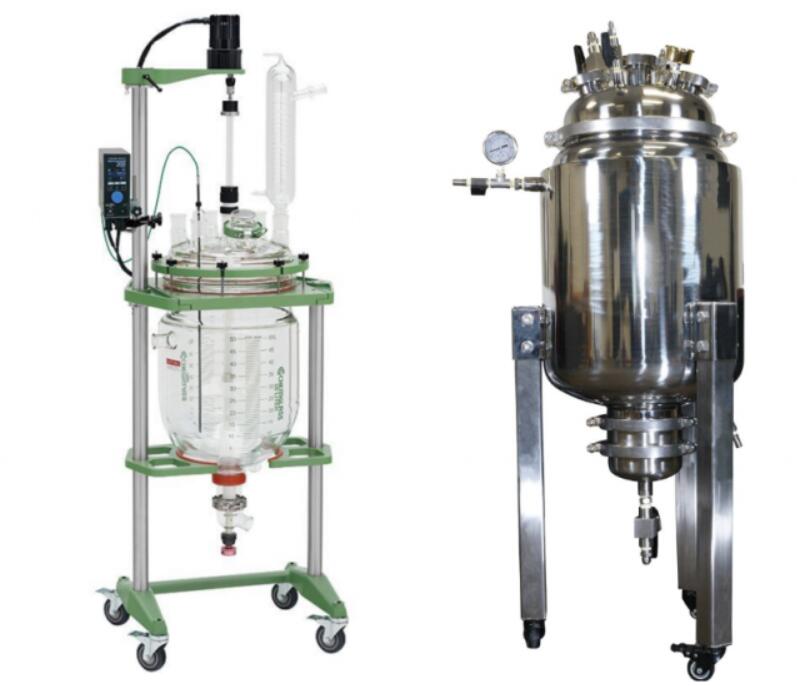
To decide whether you should buy a stainless steel or glass jacketed reactor, you must first confirm its intended applications. To extract materials from organic compounds using ethanol, for example, a stainless steel reactor is the better option. However, if you require a larger reactor for short path distillation processes, a glass reactor is better for your needs.
The Sizes of Jacketed Glass Reactor
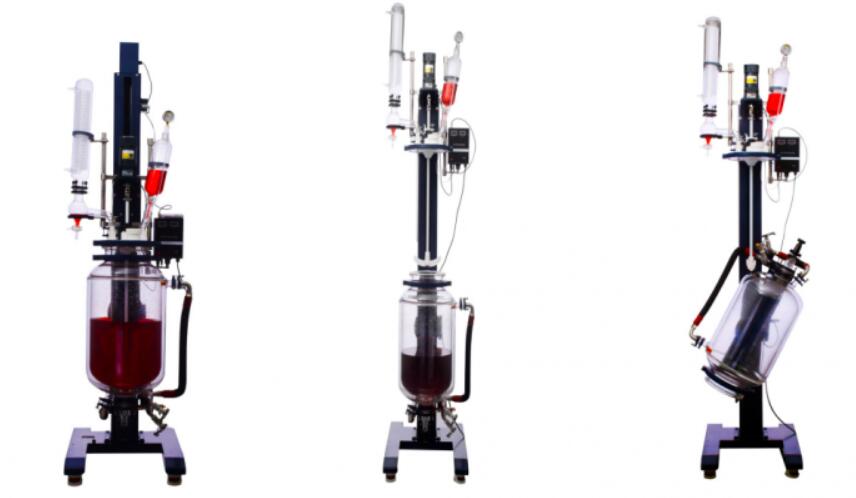
1. 5L Jacketed Glass Reactor
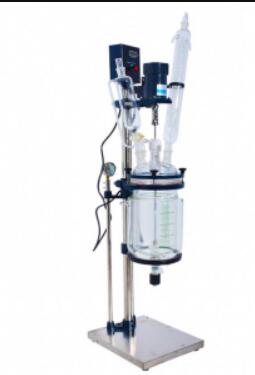
One of the most popular jacketed glass reactor sizes in the market is the 5L. WKIE Lab provides you with the best 5L jacketed glass reactor. This is used for different industrial and laboratory services such as mixing, distillation as well as reaction and several others. Most importantly, they are useful in the pharmaceutical and chemistry industry.
If you are working with cooling as well as heating circulation, this model is perfect because the temperature inside it can be controlled and maintained. And besides that, many people like this because it is the standard volume. Moreover, it is also available in desktop structure, saving plenty of space for you.
The temperate range is also variable staring from minus 60 to 200C. The glass parts are also durable, and it is made from superior quality boro 3.3 glass materials. All the wetted parts are also composed of PTFE materials. Zero dead space and bottom valve design make it the most durable in the market.
It is composed of a support frame designed with quality stainless steel material. Most importantly, the model is corrosion resistant.
2. 10L Jacketed Glass Reactor

10L jacketed glass reactor is another size option of glass jacketed reactors, which is useful for both chemical and pharmaceutical industries. The equipment can be used for different laboratory purposes like distillation as well as mixing and most importantly, it is used for the reactions. The great aspect of this kind of product is that there is a various wide range of options that are available to you. The temperature is accurately maintained inside the glass and it is also very gentle and that is why it is very popular. The temperature range of this product is minus 60 and it can reach up to 200C. Moreover, because of the design, it is pretty easier to customize the use.
Besides, the model is highly customizable. The glasses are also very durable and as usual, this is designed with the best quality boro materials as well as PTFE technology. The jacket volume is 4 liter and the reaction volume is 10L. It is important that the user knows the difference between the bottle volume and the reactor volume. It is possible that different reactors volumes can be in the same bottle. The power supply system also ranges from 220V or 110V. This is preserved at the maximum jacket pressure at 0.5 bar. The maximum speed it operates is 600 rpm.
3. 20L Jacketed Glass Reactor

20L jacketed glass reactor is the best quality jacket glass reactor. It can double or single jacketed and it is perfect for synthetic reaction of different kinds of materials and it is preserved well under controlled temperature and in a conducive vacuum environment. The reactors are designed with synthetic and adjustable speeds. If you want to add materials to that funnel, it is possible and you can do that at a controlled speed. There are other interesting features that make this model wonderful.
It is durable because of the high-quality thermal insulation jacket, and it comes with an opening and closing window. Furthermore, it features an adjustable drawstring and this is to ensure that chemicals inside the glass bottles are still potent and effective pending the time you want to use it. The jackets are also ensuring that it chills at a lower temperature and that can save you some money in the end.
Furthermore, some models are made with a double jacket and this makes it possible to draw vacuum the other jacket which is usually the outer one. This is wonderful because it can protect what you have inside the container.
Durability and quick are also key factors that make this model great. It comes with solvent resistant PTFE and this is applicable to all the sealing components and that ensures that it lasts very long.
4. 50L Jacketed Glass Reactor

50L is also another jacketed glass reactor size, serving different purposes. And one of the most important amongst them is the synthetic reaction. Besides, you can also use this to store different kinds of materials.
They are available in different adjustable stirring speeds and it works at a constant pressure. The feeding funnel is to assist you to add content to the glass. Furthermore, it comes with an inbuilt condenser and this makes it easy to recover some materials especially those that are losing. Most importantly, you can use this at a controlled speed rate.
Depending on the model you want to use, there are available in an open and close viewing window. The bottom and top part of it are designed with adjustable drawstrings. Moreover, the jacket is designed in such a way that the chill life of the content is one hundred percent guaranteed. It is easier to adjust the temperature and if you charge it, this can save you some money in terms of utility bills. The design is such that the content can draw a vacuum through the outer jackets if you are using a model with dual jackets. There is the outer jacket and the inner one.
5. 200L Jacketed Glass Reactor

200L jacketed glass reactor volume is one of the biggest in that industry, available for different purposes. In most cases, it can be used for industrial purposes, pharma, and the chemical industry. There are different designs and models in the market. Because of the great reaction volume, some of them are available in different ports, and there are models with 6 ports. Most importantly, it operates at the rotation speed of 50 to 600 rpm. The glass has different columns and compartments, serving different purposes.
It comes with a customize rectification column as well as a tail gas absorption system. And also, It is designed with the finest quality borosilicate glass materials. Furthermore, to ensure that contents are well preserved, some of them come with an integrated stainless-steel tube as well as a mobile frame structure.
Moreover, the vessel is covered with five necks and this makes it easy to control the temperature as well as the measurement. Most importantly, the PTFE seal is to keep it high and even under any poor condition, it can work. It is perfect and it is suitable for stirring paddle.
The Applications of Jacketed Glass Reactor
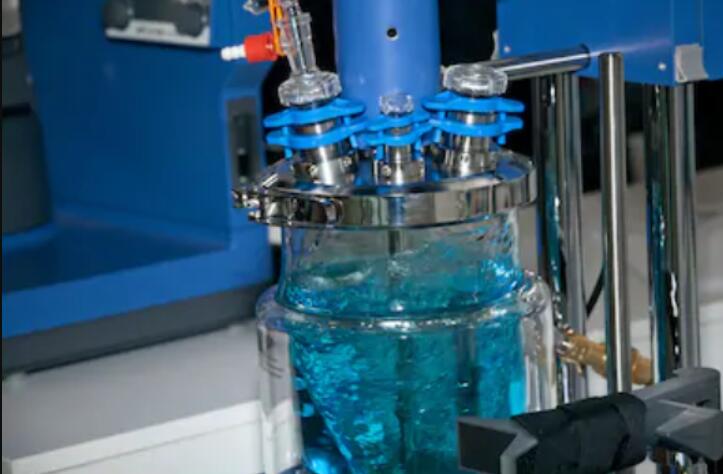
1. Jacketed Glass Reactor in Lab
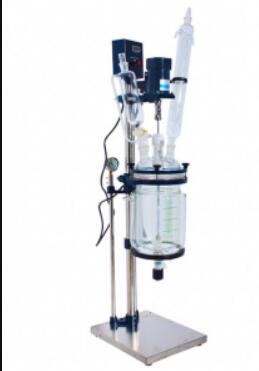
Jacketed glass reactors are used in various places such as the laboratory, chemical industries, pharma industry and they are used in chemical engineering where they are used for various kinds of reactions. This vessel is very popular and they are available in different shapes, sizes, and qualities. shapes and sizes you buy depend on the kind of reaction you want to do.
If you want to use it in the laboratory, you must ensure that it meets the parameter configuration such as evaporation reaction, heating reaction, as well as speed and cooling effect. The design is such that it can meet the functions and other things that you want to achieve with it. For your laboratory research, You can use this to carry out different kinds of reactions. There is no other reaction vessel that can compare with it. This is because it is perfect as it ensures reactants mixing and synthesis. In the laboratory, you can subject this to different kinds of reactions such as extraction reaction, homogeneous reaction, and most importantly distillation reaction as well as sample purifications and so on.
Jacketed glass reactors for use in the laboratory are often designed with the finest quality raw materials that are available in that industry. This is necessary to ensure that the reactants do not cause any harm. Most of them are designed using G-17 high-temperature borosilicate glass material. This is specifically meant for low expansion reaction, and it can work perfectly under high temperatures. Before you begin to use this, you must ensure that it is safe to use.
Check whether it is a quasi-glass material and if it is such, then you would know that it is safe to use. Most importantly, you must be aware of the various rules that you can use this type of glass in the laboratory and you must ensure that you meet that requirement to ensure that you get a piece of accurate information.
2. Jacketed Glass Reactor in Chemistry
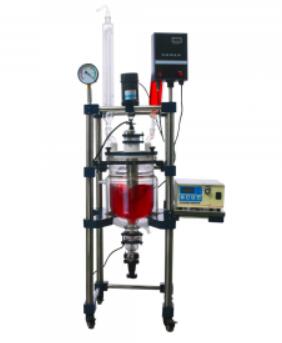
In the chemistry laboratory, especially in schools, these jacketed glasses are used to carry out different kinds of reactions. The way you use the jacketed glass reactor in the laboratory is almost the same as how you can use it in chemistry. This type of glass is unique because it has multipurpose uses.
For instance, just as you can use it in the laboratory, you can use it in the pharma industry, the chemical engineering industry and so on. It almost works on the same principle. The most important thing is to ensure that it meets the specification for that industry standard.
The glass reactor is in different capacities and ensures that the model you want to use meets the specification for that industry. In the chemical industry, it must meet the required specifications. Most of the glasses that are used for this kind of operations are often heated to ensure that chemicals mix very well.
There are lots of reactions you can do with this jacketed glass reactors in chemistry laboratories across the world such as the combination reaction. This involves a combination of two or more chemicals. Another type of reaction you can use it for includes decomposition reaction, where you break down chemicals to their components. Most importantly, you can use them for redox reaction, combustion reaction, as well as double replacement reactions and even single displacement reactions.
The Precautions of Using a Chemical Glass Reactor:
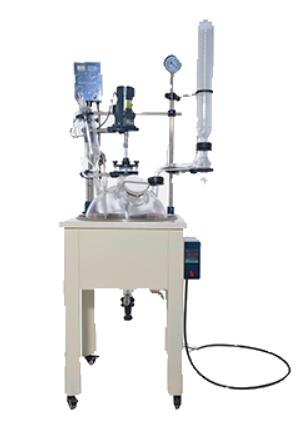
Before you use it for any of these reactions ensure that the power supply system meets the specifications you want for it. To determine the power requirement for that product, you must check the nameplate to study the power requirements as well as a specification for its industrial use.
The speed of that system is also adjustable and you have to do that based on the desired speed and the type of chemical reactions that you want to achieve. You can also control the operation or speed. Therefore, you must select the appropriate speed and temperature through the control knob.
Moreover, in this kind of operation, there is the chance of resonance and that is because of motor power as well as material flow. You must continue to vary the operation speed to ensure that resonance does not occur in the chemistry laboratory.
The seal is of utmost importance here and you must ensure that it is the best. Do not go for the degraded materials and you must also check for the rotary bearing. Most importantly, ensure that the glass you use for that operation is of the best quality. The best is designed with the best quality G-17 low expansion material as well as high-temperature borosilicate glass. Ensure that everything is perfectly in order and that is why you must ensure that you use the best quality glass for that operation. If you are using a quality material then it would be safe to use.

